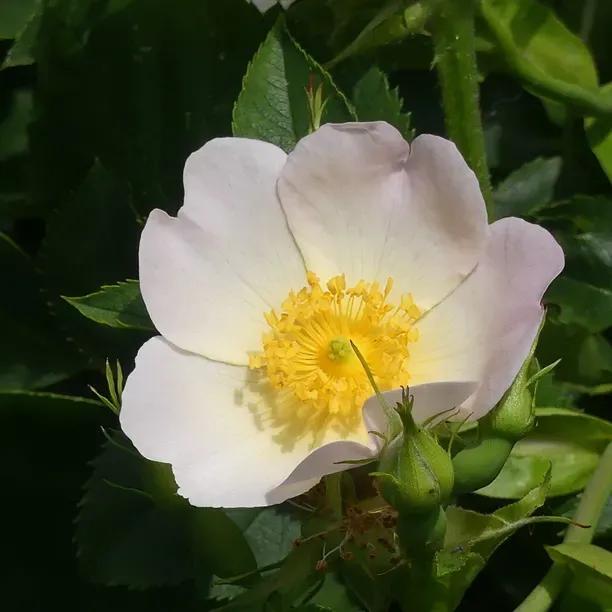Scotch Burnet Rose Hedge Plants
Honest Delivery PricesRosa pimpinellifolia
Hedge Plants- Native.
- Best wild rose for dry / exposed sites.
- Good secure hedging.
- Max. Height: 2.5m
- Bareroot Delivery Only: Nov-Mar.
Description
Rosa pimpinellifolia / spinosissima Hedging
Delivered by Mail Order Direct from our Nursery with a Year Guarantee
The Scottish Burnet Rose, is a superb hedging plant. Suitable for any soil with decent drainage.
Rosa pimpinellifolia is good for hedges up to about 3 metres high, although it won't grow that tall as a bush in the open.
A very thorny native rose that makes an excellent dense thicket; it's a natural-born secure hedge plant. It bears heavily scented white & pink flowers in summer, followed by inedible maroon-black fruit.
This rose is seriously thorny. If you don't own a pair of extra-thick gardening gloves, get some before you start handling this beast!
If you want a wild rose for dry soil, really cold or exposed sites, this is the one to go for.
View our selection of thorny rose hedging or see our full range of hedging plants.
Bareroot hedge plants are only delivered during winter (Nov-March).
All our hedge plants are measured by their height in centimetres above the ground (the roots aren't measured).
Spacing a Rosa pimpinellifolia hedge:
Plant hedging at 3 plants per metre, 33cm apart.
You can also plant at 6 plants per metre in a staggered double row, with 33cm between each plant along the row and 40cm between the rows.
Did You Know?
You may also see the Scotch rose listed as Rosa spinosissima, which means the prickliest, a well deserved name.
Planting Instructions
Growing Rosa pimpinellifolia plants:
These dense, throrny plants will thrive on dry soil and in the coldest, windiest sites. They are happy right on the coast and will grow well on limestone or chalk. Wild rose hedges can be savagely clipped in late winter. Wear eye protection with this one!
Prepare your site before planting:
Native hedge plants like Rosa pimpinellifolia are very tough. The only essential preparation is to kill the weeds in a strip a metre wide along the planting site: improving the soil should not be necessary. If your soil is exceptionally poor and dry, then digging in some well rotted manure and/or compost is worthwhile.
Watch our video on how to plant a country hedge for full details.
Remember to water establishing plants during dry weather for at least a year after planting.
Hedge Planting Accessories:
Prepare your site for planting by killing the weeds and grass.
You can buy a hedge planting pack with sheets of mulch fabric and pegs to hold it down.
If your soil quality is poor, we recommend using mycorrhizal "friendly fungi" on the roots of new trees and shrubs.
You can also improve your soil with bonemeal organic fertiliser.
After Care
After you have planted your Rosa pimpinellifolia hedge, the most important thing to do is water it in dry weather. You will also need to weed around the plants. Watering should be thorough, so the ground is soaked. Let the soil almost dry out before watering again. Watering & weeding will be necessary for at least a year after planting.
Trimming Country hedge plants:
Rosa pimpinellifolia is a vigorous, native hedging plant that benefits from being cut back hard right after planting, as shown in the country hedge planting video. In the following years, your young hedge should be trimmed lightly once in winter, until it is mature. When it is fully grown, you can clip it at anytime. Late winter is ideal.
Special notes on caring for Rosa pimpinellifolia hedges:
Rosa pimpinellifolia is a very tough hedge plant that shouldn't need special attention once it has established. If you didn't use a mulch fabric, it is beneficial to mulch around the base of the hedge each year.
Hygiene & Diseases:
Dead, damaged or diseased wood can be pruned off as soon as it appears.
Disinfect your pruning tools between every cut if there is any sign of disease.
Burn or dispose of any diseased material, do not compost it.
After you have planted your Rosa pimpinellifolia hedge, the most important thing to do is water it in dry weather. You will also need to weed around the plants. Watering should be thorough, so the ground is soaked. Let the soil almost dry out before watering again. Watering & weeding will be necessary for at least a year after planting.
Trimming Country hedge plants:
Rosa pimpinellifolia is a vigorous, native hedging plant that benefits from being cut back hard right after planting, as shown in the country hedge planting video. In the following years, your young hedge should be trimmed lightly once in winter, until it is mature. When it is fully grown, you can clip it at anytime. Late winter is ideal.
Special notes on caring for Rosa pimpinellifolia hedges:
Rosa pimpinellifolia is a very tough hedge plant that shouldn't need special attention once it has established. If you didn't use a mulch fabric, it is beneficial to mulch around the base of the hedge each year.
Hygiene & Diseases:
Dead, damaged or diseased wood can be pruned off as soon as it appears.
Disinfect your pruning tools between every cut if there is any sign of disease.
Burn or dispose of any diseased material, do not compost it.


